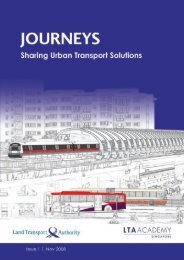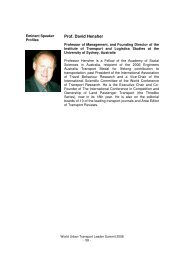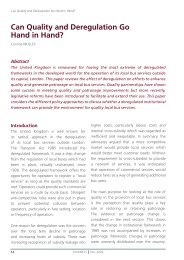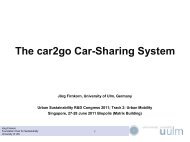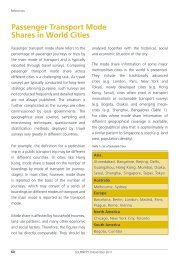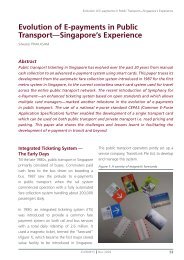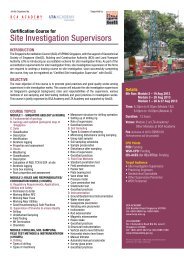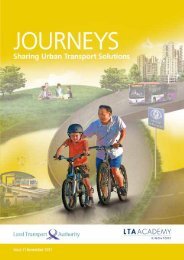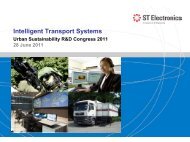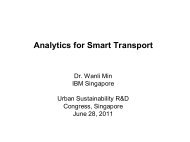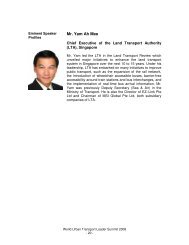Issue 4 May 2010 - LTA Academy
Issue 4 May 2010 - LTA Academy
Issue 4 May 2010 - LTA Academy
Create successful ePaper yourself
Turn your PDF publications into a flip-book with our unique Google optimized e-Paper software.
Urban Leaders Find Transportation Paths to Global Green Growth<br />
using dedicated lanes instead of mixing with<br />
traffic, spanning over 88 km and connecting<br />
the downtown commercial district of Kalupur<br />
with outlying neighbourhoods. Most of the<br />
network passes through low and middle<br />
income neighbourhoods. Janmarg is meant to<br />
improve the quality of commuting in the city<br />
through dedicated bus lanes, bicycle tracks,<br />
pedestrian facilities and parking management.<br />
Some of the infrastructure highlights of the<br />
system include segregated lanes, high floor<br />
buses, level passenger boarding, external<br />
ticketing and real-time bus arrival information.<br />
Completion of the network is expected in<br />
2011; half of the system is now in operation.<br />
Ridership is now about 32,000 passengers<br />
daily, with that number expected to grow<br />
greatly. Eventually, the city envisions an<br />
integrated fare scheme between normal bus<br />
service, Janmarg and parking. The capital cost<br />
of Janmarg was US$1.8 million per kilometre.<br />
Figure 2: Bicycle riders enjoy the first ever Summer<br />
Streets in NYC<br />
Improving Walking and<br />
Cycling Infrastructure<br />
New York City, USA<br />
More than 50 acres of road space in New York<br />
City (NYC) have been reclaimed from traffic<br />
lanes and car parking spaces to meet the goals<br />
20<br />
JOURNEYS <strong>May</strong> <strong>2010</strong><br />
of PlaNYC 2030, a comprehensive long-term<br />
sustainability vision announced on Earth Day<br />
in 2007 by <strong>May</strong>or Michael Bloomberg. A<br />
large component of the plan, after decades<br />
of car-oriented policies, is to create a more<br />
balanced transportation network in the<br />
city by the year 2030. NYC Department of<br />
Transportation Commissioner, Janette Sadik-<br />
Khan, succeeded in overseeing the creation<br />
of new public plazas and the installation of<br />
over 322 km of new bicycle lanes – 8 km of<br />
which are protected, installation of more than<br />
6,000 bicycle racks, more than two dozen<br />
bicycle parking shelters and a 45% increase<br />
in bicycle commuting (NYC Department of<br />
Transportation 2009).<br />
The city adopted a strategy that<br />
was championed by Copenhagen,<br />
Denmark – taking small nibbles of<br />
street space away from cars until<br />
reaching a groundswell of noticeable<br />
changes.<br />
The most iconic transformation occurred in<br />
Times Square with the pedestrianisation of<br />
Broadway after a century of accommodating<br />
car traffic. The city adopted a strategy that<br />
was championed by Copenhagen, Denmark –<br />
taking small nibbles of street space away from<br />
cars until reaching a groundswell of noticeable<br />
changes. Much of the street reclamations<br />
have been done initially using fast and costeffective<br />
coloured paint on asphalt, followed<br />
later by permanent reconstruction. As part of<br />
improving the street experience, over 98,000<br />
trees were planted and a Car-Free Sundays<br />
programme was launched, called Summer



